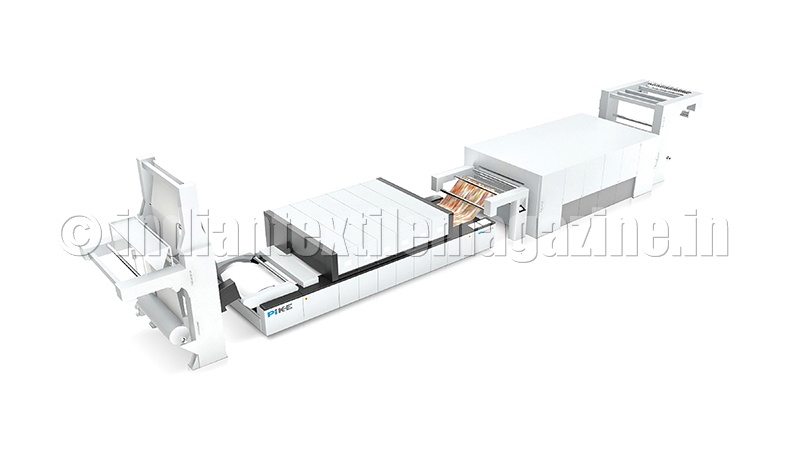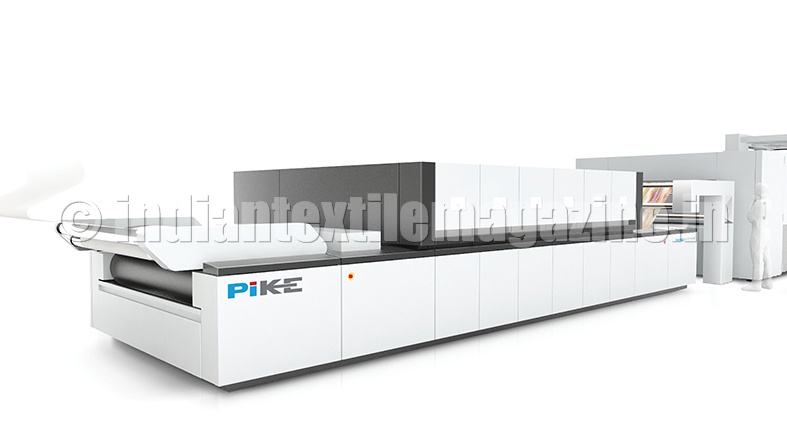SPG Prints recently welcomed key customers for a sneak preview of its new high volume, single-pass digital textile printer which will be launched at ITMA 2015 in Milan in November. Visitors to the company booth will be able to see a demonstration of the working of the new Pike printing system for high volume printed textile production.
Mr. Jos Notermans, Commercial Manager, Digital Textiles at SPG Prints, explained: “Visitors from around the world were given access to the prototype of our new ‘Pike’ printer at our headquarters in Boxmeer, the Netherlands, over a two-week period at the end of last year. We will have the actual machine running at ITMA, following which it will be shipped directly to our launch customer. We are talking about a system that is able to print approximately 13 million linear meters a year. However, the profitability of it can be proven already at volumes of 3-4 million meters per year.”
The first customer to acquire the Pike will be involved in a development and testing programme in the run-up to the printer’s launch at ITMA.
Specifications
The first Pike printer is a 6 colour machine in which each colour is represented by an Archer print bar containing 43 print heads, giving a printing width of 1850 mm. The print bar has a native resolution of 1200 x 1200 dpi, variable drop sizes from 2-10 pl and a jetting frequency of 32 kHz – a combination that delivers a typical productivity of 40 linear m/min. The system’s modular construction will accommodate models with up to 9 colours. Wider versions of the Pike, up to 3200 mm, are also being planned.

In conventional systems 8 colours are usually standard, including CMYK, red, orange, blue and grey. Jos Notermans said: “Each extra colour affects the overall price of the system, but we tried to avoid this by choosing the basic CMYK colours plus orange and blue. Because the nozzles can jet very small 2 pl droplets (compared to 5 pl, for example with Kyocera heads), we managed to avoid adding the extra grey colour bar. The latter colour range can be faithfully reproduced using CMYK black. Similarly with the red component, we defined the magenta in the CMYK colours in such a way that you can produce magenta and red with it. The 9 colour model, which will become available around 2016, will be a special one for design textile in which an extra liquid will be used to improve penetration of the ink through the substrate and which will produce even better colour fastness.”
Inks
SPG Prints has also developed Pike Reactive inks based on a formula that eliminates the problem of mist, which might have arisen with this greater firing distance. Reactive inks are intended for printing jobs involving natural fibres such as cotton. This still represents approximately 70 per cent of the business of digital textile printing.
SPG Prints is also developing disperse inks to print on polyester fibres and acid inks to print on silk and, for example, polyamide Lycra. The use of dispersion inks (comparable to the dye sublimation inks used for smaller volumes in the sign market) is the largest growth market.
The fabric infeed system on the Pike is by Erhardt + Leimer and the transport blanket has been specifically designed in conjunction with Habasit. The in-line dryer has extra capacity to handle disperse inks, which, along with acid inks, are under development and scheduled for launch in 2016.
Mr. Notermans said: “We are currently talking to a number of customers who are interested in becoming the launch customer for this product. They are aware that the image quality is far superior to anything they have come across before and are attracted by the Pike’s ability to print virtually any design – way beyond any of today’s limitations.”
Maintenance friendly
Maintenance is frequently a major issue when using these kinds of printing system. He said: “Having researched what users want from the next generation digital textile printing technology, we discovered that essential aspects include solid blotches, fine geometrics and primarily a robust industrial solution. That is exactly what the Pike delivers, at high speed and a low, predictable cost.”
Customers particularly value the proposal to cover all print head costs in the Pike inks, marketed by SPG Prints as ‘no print head headache’. It’s the reason why with respect to cost the company also plans to make its solution more attractive by offering free replacement of faulty print heads, in exchange for a ‘small’ premium on the ink price. With the cost of head replacement being a major concern for investors in fixed array machines, SPG Prints is proposing a unique arrangement in combination with Pike inks, in which the customer will initially receive a number of spare heads and any faulty heads returned will be replaced free of charge.
“The Archer print bar has been designed to retract fully for easy maintenance. Heads can be purged in narrow segments, and a faulty head can be replaced by users in less than an hour, with no need for manual alignment – simply software-based registration. The heads are manufactured using a MEMS process, which means they are less liable to deterioration and can be refurbished. And last but not the least, the fact that the Pike fits within the footprint of a rotary printer has given larger printing companies the idea to convert part of their printing capacity to digital as seamlessly as possible,” Mr. Notermans added.

